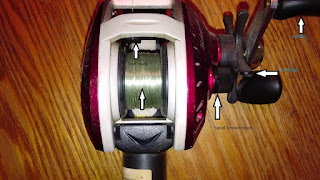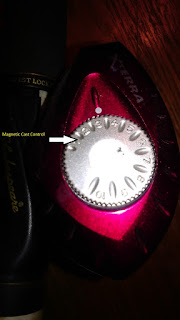Several years ago I received my first bait casting rod and reel combo as a birthday gift. I had been wanting one for some time after noticing their use in almost all fishing shows. The hosts of the shows would talk about how well the reels cast and how smooth the retrieval is, but what they don't tell you about is the backlash that happens when you don't control your line when casting. My first attempt to cast with my new reel ended up in a massive backlash that took what seemed like an hour to untangle. By the time the reel was untangled I really wanted to shove it in the corner of the garage and forget about it, but it was after all a gift from my wife so another attempt was in order. Alright now it's time for round two... Round two resulted in a worse backlash resulting in me cutting and stripping all the line from the reel and having to re-spool the reel. Keep in mind I have never used a bait casting reel in my life, so the next day at work I talked to a friend who used bait casting reels all the time. He showed me a few things that helped get my reel tuned to the bait I was trying to cast and that was all I needed, I was casting without backlash. Well not all backlash, but at least when I had some backlash it was minimal and only required pulling a little line out to get rid of it. After a lot of trial, error and practice I finally feel proficient enough to take this reel on most any fishing trip.
Here are the basic parts of a bait casting reel, and some tips on adjusting your reel. You can click the photos for a larger image.
Star Drag: The star drag is located between the handle and the side plate. The drag setting allows fish to pull line from the spool after being hooked, keeping the line from breaking from too much tension. To set the drag turn it clockwise to add tension and counter clockwise for less tension.
Spool Tension Knob: The spool tension knob helps you get better casts and helps lessen the amount of backlash. This is an important adjustment for people new to bait casters. To make this adjustment hold the rod at a 45 degree angle and release the spool applying pressure to the line on the spool using your thumb. Make small adjustments to the knob until the lure slowly falls to the ground without having to hold your thumb on the line. When the lure hits the ground without backlash the spool tension knob is set properly. You will need to set this every time you change lures.
Magnetic Cast Control: This setting will fine tune your spool speed, helping to eliminate backlash. When first learning to use a bait casting reel start with a higher setting, and after you get more comfortable you can adjust it to a lower setting.
If you are adding line to the spool fill it to 90%, to much line or to little can cause problems with casting accuracy and distance.
When you cast, bring the rod to the 11o-clock position, release the spool while applying pressure with your thumb. Swing the rod forward applying minimal pressure on the spool, as your lure approaches it landing point stop the spool by applying pressure with your thumb.
The most important thing to learn is how much pressure you apply with your thumb to the spool when casting. Not applying enough pressure will make cause the spool to spin too fast causing backlash, and too much pressure will cause shorter casts.
These tips on setting up a bait casting reel should help you get started, but nothing will get you more familiar with bait casting than practice.
Do you have any tips for using a bait casting reel?


No comments:
Post a Comment
Let me know what you think about the post you just read.